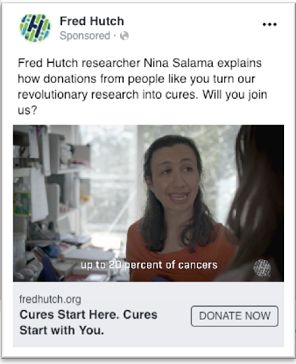Social media has never been more relevant than it is today. Facebook stated an estimated global audience of 2.38 billion monthly users in April 2019 in their reports to Wall Street. Even after the data privacy breach in September 2018 that effected 30 million users, Facebook is the most active social media channel today.
If you’re one of these 2+ billion active users on Facebook, then you’ve most likely seen a recent outpouring of video ads taking over your news feed. A recent study by BuzzSumo looked at 777 million Facebook posts and found that the most engaging type of post was video. More and more marketers are quickly jumping on board with the video trend to stay relevant. Now that you know the importance of video, here’s what you should consider when developing video ads on Facebook:
Objective is first.
When building out your Facebook ad, it’s important to know your objective. This will guide the content, design, and channel strategy. What are you wanting to achieve with your campaign? Are you looking to increase engagement, average gift, or other goal? A clearly defined objective will not only help you measure the effectiveness, but it will also inform the type of content you post and who you post it to.
Video length matters.
Facebook video ads can be up to 120 minutes in length. This is extremely long and with all the competing personal videos and ads on Facebook, users tend to watch for only 30 seconds. Facebook reports that 65% of people who watch the first three seconds of a video will watch for at least ten seconds and 45% continue watching for thirty seconds. Make sure to deliver your value proposition or call to action (CTA) at the very start of your video. And testing is your best friend. Test multiple length variations per campaign to see what works best for your audience.
Copy should align.
Clearly communicate your message with your thumbnail image and your ad copy. And, be sure the thumbnail used follows Facebook’s text/image requirements to avoid disapproval. The video and text together should explain what you are promoting, what action the users should take and why it’s important for them to do so.
Below is an example of a cancer center client’s video ad for one of their annual giving campaigns. The thumbnail image immediately communicates to the audience the CTA of giving to help cure cancer and includes an image of a researcher to visually tie into the message. You’ll also notice the copy speaks to all the great breakthroughs scientists were able to make because of generous supporters. Opening with a donor focus statement is a great way to grab the attention of the user and motivate them to continue to read through the message. The copy continues to demonstrate how important they are in the fight to cure cancer which adds that emotional connection to motivate them to give again.

Sound should not lead your message.
People like having the option to opt in to hearing sound on Facebook. A lot of time, people quickly go through their news feed in public settings, and more often than not, sound is not appropriate in these scenarios. Make sure to include captions or animated graphics to tell your story visually and capture attention immediately. Facebook reports show that captioned video ads increase video view time by an average of 12%.


If you include all these considerations when building your video ads, they can work very well for increasing engagement, with potentially high click-through rate (CTR).
For example, last December a client ran static images and video ads communicating the same message for their year-end campaign. The video ads had an average CTR of 0.21% that was over 63% higher than static ads overall and also had a higher average gift. Results could be due to it being a match campaign or that it was a year-end campaign. Although the video was great with increasing engagement, it had the second lowest conversion rate out of the ad types.
We’ve also seen video do great for events. In a current campaign for a client’s Sports Festival 5K and 10K Trail Run, the video ads have driven 32% of all conversion results despite being just two out of the 24 ads. It has driven seven conversions (donations and registrations) over a short period of time since launch in late April of 2019.
If you have the bandwidth, always include multiple ad versions and formats per campaign to maximize your return on ad spend (ROAS). Continue to experiment and be ready to adapt to the ever-changing environment and let your analysis lead your decisions.











